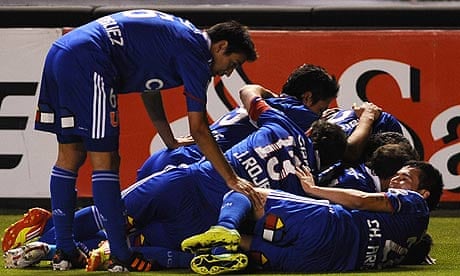The perfect year remains on. They won the Apertura, they lead after the away leg of their Clausura quarter-final and, on Thursday night, Universidad de Chile beat Liga de Quito 1-0 in the away leg of the Copa Sudamericana finals. Much will be made of the fact that the goal was scored by Eduardo Vargas, who has been linked with both Milan clubs and Chelsea, but this was a victory born of a tactical tweak by their coach Jorge Sampaoli.
There had been some speculation before the game that Universidad would abandon their habitual 3-4-3 for a 4-4-2. In fact, they ended up playing something most unusual: a 3-1-4-2, with Albert Acevedo sweeping in front of the back three. It's not uncommon, particularly in South America, where three-at-the-back systems are a much more common sight than they are in Europe, to see teams play a 3-3-2-2 – essentially a 3-5-2, but with a deep-lying midfielder sitting level with a notional intermediate position for the wing-backs. Here, though, even when lining up for goal-kicks, it was clear that these were wing-backs with an attacking brief; wide midfielders rather than defenders.
Sampaoli is a disciple of Marcelo Bielsa, who coached Chile between 2007 and 2011, and his selection logic was notably Bielsan: the idea was presumably was for UDC's wing-backs, Matías Rodríguez and Eugenio Mena, to engage those of LDU, Néicer Reasco and Paúl Ambrosi, as high up the pitch as possible and not surrender territory on the flanks. It was an intriguing ploy and a successful one, effectively withdrawing a forward from their usual lineup and deploying him as a shield in front of the defence, liberating the wing-backs by doing so.
It was a risk, because a feature of LDU's style is their long balls into the corners – an obvious tactic against a side playing three at the back. Only occasionally did that rattle Universidad, though, and only on the LDU right, where Reasco, his stamina undiminished at 34, kept threatening to burst into the space behind Mena.
Both LDU's best chances of the first half sprang from that area. First Fernando Hidalgo played the ball in from the right for Claudio Bieler, who dinked it over the defence for the onrushing Reasco. Jhonny Herrera, who made a series of fine saves against Vasco da Gama in the semi-final, made another excellent block. And then, three minutes before the break, Reasco and Ezequiel González created space on the right, the latter crossed and Hernán Barcos, arriving at the back post, fired over a gaping net.
If it looked a costly miss then, it looked even worse a minute later. Acevedo, showing the advantage of having the extra cover in front of the defence, headed a long ball clear to Charles Aránguiz. He helped it on to Marcelo Díaz, who waited, timing his pass perfectly. Vargas had barely been involved until then but, having drifted right into his more usual role on the flank, he darted inside, accepted the pass, rounded Alexander Domínguez and, with some deliberation, belted in his 10th goal of the competition.
In its immediate context it felt like a smash and grab, but UDC had unsettled LDU with their pressing early on. Their version of the tactic may not be as sophisticated as some, but its rigour has led UDC to commit more fouls than anybody else in the Sudamericana this season, and also brought bookings before the hour mark for both their forwards, Vargas and Gustavo Canales. They should have had a penalty in the opening 90 seconds as Norberto Araujo lunged into Canales as he attempted to clear a Diaz cross, but the Argentinian referee, Diego Abal, saw nothing wrong.
With fouls proliferating, there was a raggedness about the second half, as LDU became increasingly desperate and UDC's pressing lost its urgency as fatigue set in. Although the game finished in a welter of LDU pressure, a period that had Sampaoli fizzing around his technical area, his chunky tracksuit and white baseball cap giving him the appearance of a hyperactive and portly Tony Pulis, the clear chances were evenly distributed.
Domínguez blocked bravely from Aránguiz, laid in by an astute pass from Rodríguez. The latter then shanked his shot badly wide after being laid in by Aránguiz. At the other end, Barcos blasted over after Herrera had flapped at a corner and José Manuel Rojas was fortunate a goalbound Hidalgo header deflected over off his shoulder. LDU looked dangerous from set-plays; UDC threatened repeatedly on the break.
Vargas, by far the most hyped player on the pitch, was relatively quiet. At his best, he resembles a less technical, more direct version of Alexis Sánchez, always looking to sweep in from that right flank, and it may be that the more central role he occupied last night blunted his edge. Or perhaps, simply by occupying defenders, creating space for the sallies of Aránguiz and Díaz, he did his job. In the end, he did enough: when the chance came he took it superbly.
If UDC complete the job in Santiago next Wednesday (or, for those in the UK, early next Thursday morning), they will become the first Chilean side to win a continental title in 20 years. More than that, though, they will have done so playing fast, incisive, hard-pressing football. This is the harvest of the idealism Bielsa took to Chile four years ago.

Comments (…)
Sign in or create your Guardian account to join the discussion